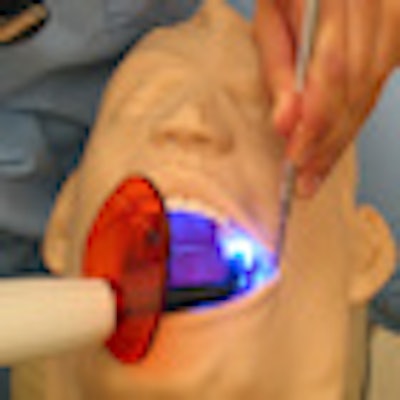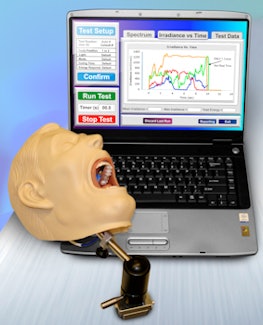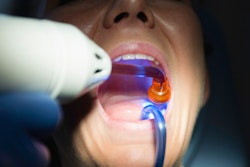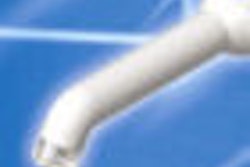
Many dentists may be using their curing lights badly, with some baking their patients' teeth and others leaving restorations uncured, a study by Dalhousie University researchers suggests.
"Most dentists think if you waft the light in the mouth somewhere, it's going to cure the restoration," said Richard Price, B.D.S., D.D.S., M.S., a Dalhousie professor of prosthodontics. "We've discovered that there is a huge difference among operators. It can be an order of magnitude."
— Frederick Rueggeberg D.D.S., M.S.
The study made use of the Managing Accurate Resin Curing (MARC) device, which Dr. Price invented for measuring the energy delivered to teeth.
MARC consists of a manikin head with sensors in two resin teeth connected to a spectroradiometer. For the study, presented in March at the American Association for Dental Research meeting in Washington, DC, 10 dentists and 10 dental students were given curing lights and asked to pretend they had placed restorations on these teeth. They demonstrated their typical technique for curing.
The energy delivered to the teeth ranged from 2.6 to 17.4 J/cm², the researchers found. "If you deliver 2 joules, the restoration is hard at the top and soft at the bottom," Dr. Price said. "If you deliver 20 joules, you're cooking the tooth."
Although filling material manufacturers don't typically provide guidelines about how many joules of energy will cure their products, that amount can be inferred to average about 10 joules, Dr. Price said.
 |
| The MARC is sold with a dedicated laptop computer. Image courtesy of Coin Deacon. |
In the study, the researchers found no significant difference between students and dentists (p > 0.01), but did find a significant difference among four different curing lights (p < 0.01) and between the energy delivered to the Class I and Class V locations (p < 0.01).
The MARC attempts to address a significant problem in verifying the success of dentists' curing lights. Not only do curing lights vary in the amount of energy they emit, but that energy can change with the life of the light. Resin composites also vary in the amount and spectrum of light they need to properly cure.
In addition, restorations can harden at the top a long time before the bottom is cured, so it's impossible to know by looking or touching whether they are completely cured, Dr. Price said. And the technique that works well with one class or location of restoration might not work with another.
In the MARC, the anterior sensor is at a depth of 1 mm, while in the posterior the sensor is at a depth of 4 mm. In that way, the light at the bottom of a restoration can be measured, Dr. Price said.
What about radiometers?
Typically, dentists gauge the effectiveness of their curing lights using dental radiometers. These are helpful for determining whether a light is losing power, but even under ideal conditions they are not very accurate, Dr. Price said. And they can't be used under conditions that simulate the way dentists actually use their lights. For example, dentists hold their lights at some distance from a real restoration but right up against the radiometer.
Dr. Price hopes the MARC can help dentists learn better curing light technique. To test whether it could, Dalhousie researchers gave 20 dental students an Optilux 401 quartz-tungsten-halogen light (Kerr Dental) and asked them to pretend to cure a Class I restoration in tooth 27 in the MARC. The students delivered a mean of 7.9 ± 2.7 J/cm² in 20 seconds. The researchers then instructed the students in proper curing light technique and repeated the experiment. They found that this time the students delivered a mean of 10.0 ± 1.4 J/cm², a significant improvement (p < 0.01).
"It's a tremendous teacher of how to use your curing unit," said Frederick Rueggeberg, D.D.S., M.S., director of dental materials at the Medical College of Georgia, who has used MARC in some courses but has no commercial interest in it. "The improvements are astounding."
Common mistakes
One of the most common mistakes practitioners make is not wearing blue blocker glasses, Dr. Rueggeberg said. That forces them to look away from the tooth. "It's like dropping something when you drive," he said. "You bend down to pick it up and the next thing you know you have swerved across two lanes."
Another common mistake is not shining the light perpendicularly to the restoration surface, or holding the light too far from the restoration.
The MARC complements a technique Dr. Rueggeberg teaches for measuring how well a particular light works with a particular composite resin, at different times and distances, by curing a sample of composite resin in a compule, he said.
But the sticker price -- $9,500 --- is likely to deter most dentists from buying a MARC to use in their offices. "It's mostly a teaching tool," said Dr. Price, who could earn royalties from sales of the invention by the company set up to sell it, Bluelight Analytics of Halifax, Canada.
For now the company envisions selling it mostly to schools and researchers, but it hopes to develop a less expensive version for clinicians.
Copyright © 2010 DrBicuspid.com



















